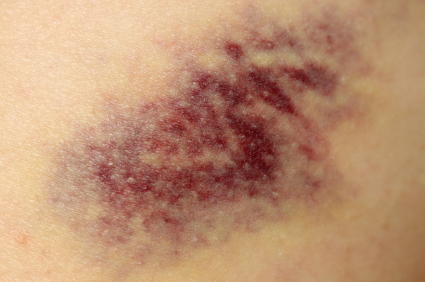Bruises
Bruises are dark colored areas of the skin which may be raised in the center. They are caused by bleeding underneath the skin near the surface. When the bleeding causes a raised area, the area is called a "hematoma.” A bruise may have a bump or knot in the middle. Bruises are very common in people with bleeding disorders. Although a bruise may seem lumpy and slow to disappear, it is not a cause for alarm unless it is very big or on the head.
Signs of bruises:
- A dark-colored area of the skin which may be raised in the center.
- Bruises don't usually hurt as much as muscle bleeds. If a bruise does hurt, it may be a throbbing pain rather than a constant one.
How to treat bruises:
- Mild bruises rarely need treatment with factor concentrate.
- When you take a hard bump or hit to your skin, press down firmly on the skin to lessen the bruising.
- Apply an ice pack to a bruise as soon as possible. The cold will slow the bleeding from the small blood vessels under the skin. Remember that using ice does not replace using factor if it is needed.
- If a lump in the bruise keeps getting bigger or if a lump appears a day or so after the blow, you may need to take factor. Check with your doctor.
- You can apply a warm cloth to a bruise 24 hours after it appears. It may help it go away sooner.
Remember these things, too:
- Bruises are seldom painful or serious enough to need factor.A bruise changes color as it heals. You can tell how old it is by the color. A new bruise is blue or burgundy. As it ages and fades, it may turn green and then yellow. It usually takes two weeks for a bruise to disappear all the way.
- Babies with bleeding disorders can bruise just from being held and handled. Don't let this stop you from picking up your baby. All babies need to be held! Scoop your baby up by placing your hands and arms under him. This causes fewer bruises than grabbing him around his chest and lifting.
- Toddlers get bruises on their arms, legs, and faces as they learn to walk and climb. This can be embarrassing - the child may look "abused". It is much better, however, to let a child explore and play than to shelter him out of worry about what other people may think.
How to prevent bruises:
- Learn the safety rules for any new sport before you begin.
- To prevent bruises in toddlers, put knee pads on the child's pants and give the child soft toys.
- Put pads on the edges of coffee tables and the bricks around a fireplace. Pad other hard things in the house that toddlers may bump into.
Call your doctor or treatment center if:
- You start bruising on your head or neck.
- You feel swelling, numbness, or a tingling feeling along with the bruise. This could mean that leaking blood is putting pressure on the nerves and blood vessels. This pressure can cause permanent damage.
- The bruise hurts.
- You have a hard time moving.
- The lump in the bruise gets larger or does not go away.
- The bruise was caused by a blow to your head or stomach. You could have damage inside your body.
